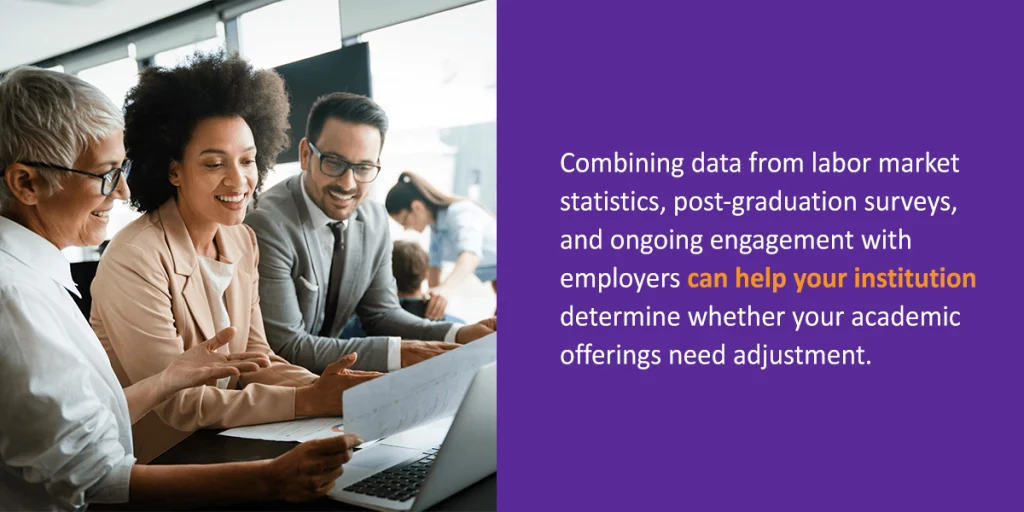




Becoming a data-driven organization means using data for decision-making at every level of the company. At institutions of higher education, data-driven decision-making is becoming increasingly important due to declining enrollment and financial hardships.
Analyzing labor market data can help higher education institutions (HEIs) combat the growing sense of apathy among young people by showing them concrete evidence of how an associate’s, bachelor’s, or graduate degree can help them achieve professional success.
The potential applications also go beyond helping prospective students. Let’s explore the valuable insights you can glean from analyzing current labor market trends and how they can help your institution.
Here are some of the most effective ways HEIs are leveraging labor market data for institutional decision-making today.
Although a student may be a great fit for an occupation that’s in high demand, they may not know enough about the typical wages or necessary credentials to want to pursue it. It’s also possible that students may never have even heard of these jobs before, which can set them back from finding their dream career.
Institutions can use labor market data to connect these jobs directly to their academic programs, which opens students up to a whole new world of opportunity and improves the institution’s reputation.
Growing apathy among high school students — the traditional demographic for most higher education institutions — isn’t the only reason behind declining enrollment trends.
Shrinking birth rates since the Great Recession mean there just aren’t as many young people in the country as there used to be. Institutions will need to respond to this shift by turning to nontraditional student demographics.
Many working professionals today are looking for opportunities to upskill, reskill, or change career paths entirely. Analyzing labor market data can reveal who these individuals are and which skills are in demand — data institutional leaders can use to recruit these learners for programs that meet their needs.
It’s extremely common for undergraduate students to change majors at least once over the course of their higher ed journey. Often, students change their minds about their career paths because they learn about new opportunities and changes within the labor market that they never had access to before.
Labor market data can help students better understand factors like employment outlook, potential wages, and how their own interests should play into deciding on a job, making it easier to decide on a defined career path.
Making this data readily available to students can also help those who come in without a declared major arrive at a decision faster, which can significantly improve their chances of graduating on time.
It can also be tough choosing a major when you have many interests that don’t align neatly with any existing programs. That’s why many institutions now offer personalized degree paths — often called “interdisciplinary” or “individualized” courses of study. These programs enable students to create a major that reflects their unique interests and career aspirations.
Labor market data can reveal long-term and emerging regional trends that connect directly to elements in specific programs. This information can help students pick and choose the courses they need to create an independent degree program that is most likely to help them secure a job in their desired field.
A popular program in a growing field sounds like a recipe for success, but if it isn’t as rigorous or reputable as similar programs at competing institutions, there’s a chance that graduates won’t get the jobs they want after graduation.
Let’s take nursing as an example. Many nursing schools build relationships with nearby healthcare facilities, which helps students find clinical study placements. For many graduates, this relationship is essential for finding permanent employment after receiving their nursing licenses.
Combining data from labor market statistics, post-graduation surveys, and ongoing engagement with employers can help your institution determine whether your academic offerings need adjustment.

While a program has strong enrollment numbers and high completion rates, that doesn’t necessarily mean graduates will go on to gain employment in the field. Schools should consider whether their existing programs are producing enough — or too many — graduates for the number of opportunities available. Analyzing labor market data can help administrators evaluate whether their institutions should grow or downsize certain programs to match the conditions in the job market.
On a similar note, institutions may need to cut programs that lead to careers in dying fields. For example, while a program could produce hundreds of excellent graduates every year, the profession might be so saturated that very few end up gaining employment in the field. Or labor market disruptions could eliminate opportunities for advancement.
Labor market data can help institutions get a more accurate understanding of specific professions so they can determine whether programs are truly setting students on pathways that lead to success. If a specific program is geared toward a dying or oversaturated profession, the institution can pivot its focus to more valuable courses of study.
Insights derived from labor market data can help you prove your institution’s value to:
Having a convenient, user-friendly software solution makes this data more easily accessible to all the necessary stakeholders.
If you’re looking for an easy way to view, analyze, and share labor market data with your institution’s stakeholders, Watermark can help. We’ve partnered with Lightcast, a leader in global labor market analytics, to create the Market Landscape Data Pack — part of the Watermark Planning & Self-Study software solution.
The Market Landscape Data Pack allows institutional leaders to analyze vital job market factors like regional job trends, compensation trends, degree completions by institution, and more. And with its intuitive, user-friendly dashboard, this solution makes accessing and understanding your data easy for all stakeholders.
Request a free demo today to see our Planning & Self-Study solution in action, or contact us online for more information about our software.






























































































































































































































































































































































































